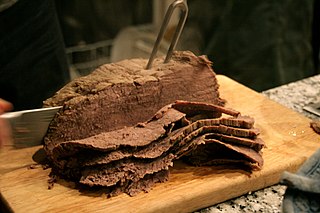
A jack-o'-lantern is a carved pumpkin, turnip, or other root vegetable lantern associated with Halloween. Its name comes from the phenomenon of a strange light flickering over peat bogs, called will-o'-the-wisp or jack-o'-lantern. The name is also tied to the Irish legend of Stingy Jack, a drunkard who bargains with Satan and is doomed to roam the Earth with only a hollowed turnip to light his way.

Cameo is a method of carving an object such as an engraved gem, item of jewelry or vessel. It nearly always features a raised (positive) relief image; contrast with intaglio, which has a negative image. Originally, and still in discussing historical work, cameo only referred to works where the relief image was of a contrasting color to the background; this was achieved by carefully carving a piece of material with a flat plane where two contrasting colors met, removing all the first color except for the image to leave a contrasting background.

Wood carving is a form of woodworking by means of a cutting tool (knife) in one hand or a chisel by two hands or with one hand on a chisel and one hand on a mallet, resulting in a wooden figure or figurine, or in the sculptural ornamentation of a wooden object. The phrase may also refer to the finished product, from individual sculptures to hand-worked mouldings composing part of a tracery.

Netsuke (根付) are miniature sculptures that were invented in 17th-century Japan to serve a practical function.

Stone carving is an activity where pieces of rough natural stone are shaped by the controlled removal of stone. Owing to the permanence of the material, stone work has survived which was created during our prehistory.

Ice sculpture is a form of sculpture that uses ice as the raw material. Sculptures from ice can be abstract or realistic and can be functional or purely decorative. Ice sculptures are generally associated with special or extravagant events because of their limited lifetime.

Snow sculpture is a sculpture form comparable to sand sculpture or ice sculpture in that most of it is now practiced outdoors, and often in full view of spectators, thus giving it kinship to performance art in the eyes of some. The materials and the tools differ widely, but often include hand tools such as shovels, hatchets, and saws. Snow sculptures are usually carved out of a single block of snow about 6 to 15 feet on each side and weighing about 20 - 30 tons. The snow is densely packed into a form after having been produced by artificial means or collected from the ground after a snowfall.

The Gourds are an American alternative country band that formed in Austin, Texas, United States, during the summer of 1994. After playing together for 19 consecutive years, the band went on hiatus in 2013.

Ivory carving is the carving of ivory, that is to say animal tooth or tusk, by using sharp cutting tools, either mechanically or manually.
The art of chainsaw carving is a fast-growing form of art that combines the modern technology of the chainsaw with the ancient art of woodcarving.
Cheryl Ann Fulton is an American harpist. Fulton performs, records, teaches, and researches the harp. She is a performer of historical harps, and one of the few harpists to play triple harp, medieval harp, and lever harps.

A stone sculpture is an object made of stone which has been carved or assembled to form a visually interesting three-dimensional shape.

The Indiana State Library and Historical Bureau is a public library building, located in Indianapolis, Indiana. It is the largest public library in the state of Indiana, housing over 60,000 manuscripts. Established in 1934, the library has gathered a large collection of books on a vast variety of topics.

Lego Indiana Jones: The Original Adventures is a Lego-themed action-adventure video game developed by Traveller's Tales and published by LucasArts. The game allows players to recreate moments from the first three Indiana Jones films: Raiders of the Lost Ark (1981), Indiana Jones and the Temple of Doom (1984), and Indiana Jones and the Last Crusade (1989). It features the same drop in/out co-operative play mode as seen in the Lego Star Wars video games, although it is restricted to local console play. The game was released on 3 June 2008 in the United States and Canada, and 6 June 2008 in Europe. A downloadable demo for Windows was made available on 13 May 2008. This game is based on the Lego Indiana Jones toy line. The Mac OS X version of the game was released on 4 December 2008 by Feral Interactive.

Theodorus Johannes "Theo" Schoon was a New Zealand artist, photographer and carver of Dutch descent.

Carvings , is a series of bas-relief limestone panels decorating the facade of the Indiana State Library in Indianapolis, Indiana, United States. The reliefs were designed by artist Léon Hermant and carved by German sculptor Adolph Wolter in 1934. The panels on the east facade are approximately 80 × 80 × 5 inches, the low panels on the east facade are approximately 18 × 18 × 1½ inches and the classical figures are each approximately three feet by two feet by three inches. The library building was dedicated Dec. 7, 1934.

Griffon E. Ramsey is an American chainsaw carving artist known for her pop-culture wood sculptures which have appeared at the Australian Chainsaw Carving Championships and the Butler Chainsaw Carving Invitational. Chip Chats magazine described her as a "world-famous" artist with an, "edgy and bold style" while VICE and Uproxx called her a, "rock star of the art world" and noted her being a female in a largely male dominated field.
This page is based on this
Wikipedia article Text is available under the
CC BY-SA 4.0 license; additional terms may apply.
Images, videos and audio are available under their respective licenses.


















